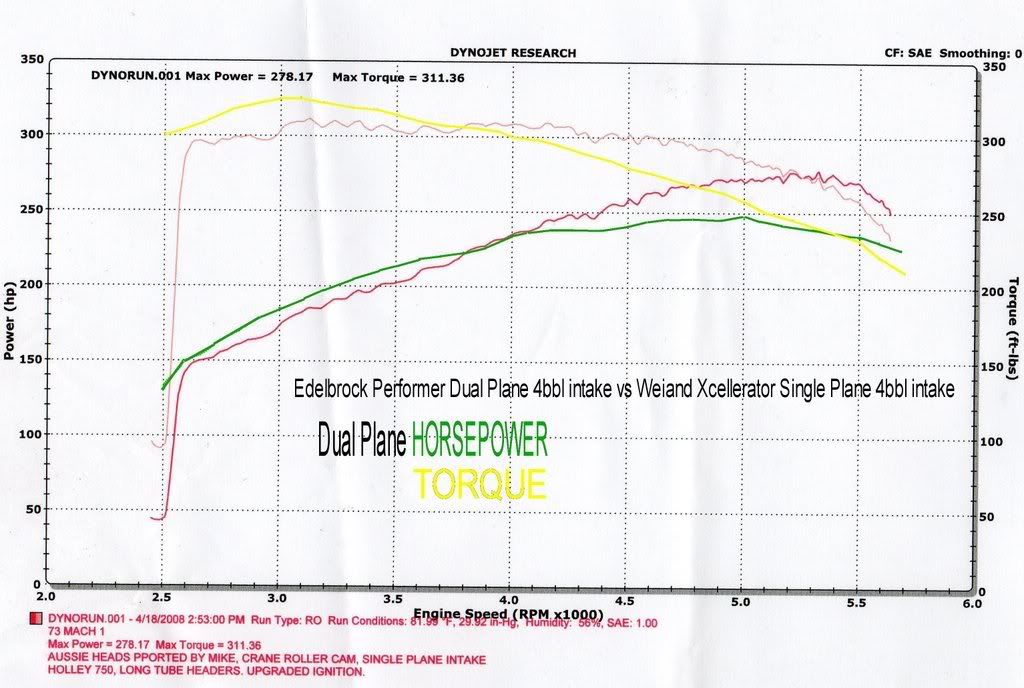- Joined
- Aug 14, 2014
- Messages
- 4,313
- Reaction score
- 1,360
- Location
- Madison, WI
- My Car
- 1971 Mach 1 w/408C stroker
Yesterday I went to a car shop nearby where they had a Mustang type dyno. The place is amazing, they have a race team and work on all kind of sports cars including Porsche, Ferrari, Lotus, etc.
My goal was to have a baseline so I can see what my improvements over the winter will produce. This was a Mustang dyno and the numbers were on the low side. After researching and reading a lot it seems that there are many rule-of-thumbs people have to convert this results into engine HP. It seems to me that it is very hard to know what the real HP is. Even more difficult is that I have an auto trans. At least it will be a good benchmark to see the effect of future improvements. I see it more of a relative measurement rather than absolute.
My M-code Mach 1 hit 200 rwHP @ 4600 rpm and 258 lb.ft @ 3000 rpm (ignore high torque reading at beginning of run) My engine appears fairly factory except for a 670 cfm Holley carb, a 272H cam and a dual 2" exhaust system with an H. The factory specs are 285 bhp @ 5400rpm and 370 lb.ft @ 3400rpm.
The guy stopped the run at 5000 rpm based on the HP dropping. As far as I know it should have gone to 6000 with no problem. You can see that torque peaked 400 rpm earlier and HP peaked 800 rpm earlier. I don't know if he would have continued the measurement past 5000 rpm if the HP would have bounced back. Maybe the 2" exhaust is choking the engine too much.
In this dyno the RPM is measured based on the wheel drum rotation. They first sync the engine RPM to the wheel RPM by making a 3000 rpm run. For this they picked up the RPM from the spark plug wire.
There could be a delay between the engine RPM and the wheel rpm, but it should be relatively small. I also run it in 2nd gear. Ideally would have been in 3rd gear which is 1-to-1, but I calculated that it would have the wheels spinning at 160 mph due to my 3.0 axle ratio. I did not feel comfortable rotating those tires that fast. In 2nd gear 5000 rpm was about 90 mph, which is more manageable.
Does any of you have experience with Mustang dyno results? Thoughts on these results?


My goal was to have a baseline so I can see what my improvements over the winter will produce. This was a Mustang dyno and the numbers were on the low side. After researching and reading a lot it seems that there are many rule-of-thumbs people have to convert this results into engine HP. It seems to me that it is very hard to know what the real HP is. Even more difficult is that I have an auto trans. At least it will be a good benchmark to see the effect of future improvements. I see it more of a relative measurement rather than absolute.
My M-code Mach 1 hit 200 rwHP @ 4600 rpm and 258 lb.ft @ 3000 rpm (ignore high torque reading at beginning of run) My engine appears fairly factory except for a 670 cfm Holley carb, a 272H cam and a dual 2" exhaust system with an H. The factory specs are 285 bhp @ 5400rpm and 370 lb.ft @ 3400rpm.
The guy stopped the run at 5000 rpm based on the HP dropping. As far as I know it should have gone to 6000 with no problem. You can see that torque peaked 400 rpm earlier and HP peaked 800 rpm earlier. I don't know if he would have continued the measurement past 5000 rpm if the HP would have bounced back. Maybe the 2" exhaust is choking the engine too much.
In this dyno the RPM is measured based on the wheel drum rotation. They first sync the engine RPM to the wheel RPM by making a 3000 rpm run. For this they picked up the RPM from the spark plug wire.
There could be a delay between the engine RPM and the wheel rpm, but it should be relatively small. I also run it in 2nd gear. Ideally would have been in 3rd gear which is 1-to-1, but I calculated that it would have the wheels spinning at 160 mph due to my 3.0 axle ratio. I did not feel comfortable rotating those tires that fast. In 2nd gear 5000 rpm was about 90 mph, which is more manageable.
Does any of you have experience with Mustang dyno results? Thoughts on these results?


Last edited by a moderator:







